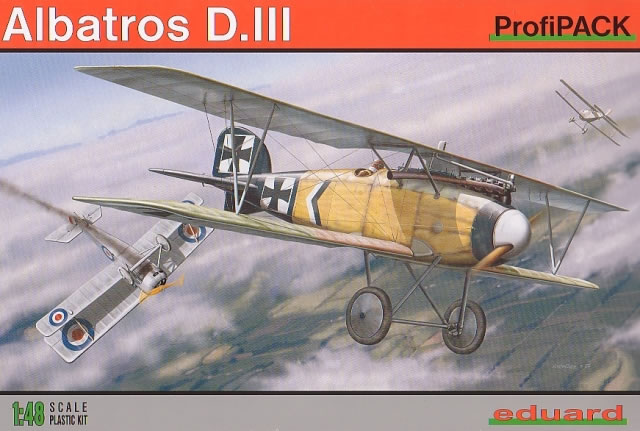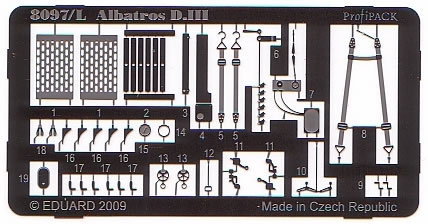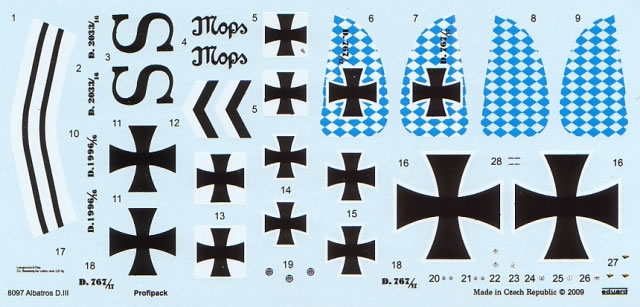|
Albatros D.III
Profipack

Eduard, 1/48 scale
S
u m m a r y |
| Catalogue Number: |
Eduard Kit No. 8097 - Albatros D.III Profipack |
| Scale: |
1/48 |
| Contents and Media: |
Olive coloured plastic parts; photo-etched parts; markings for five aircraft. |
| Price: |
USD$29.95 plus shipping available online from Eduard's website
and specialist hobby retailers worldwide |
| Review Type: |
FirstLook |
| Advantages: |
Crisp moldings, excellent detail; intelligent use of photo-etched parts; set of flexible masks; wings with subtle rib detail and sharp trailing edges; decal sheet in perfect register with minimal carrier film; great value for money. |
| Disadvantages: |
Undernourished main wheels. |
| Recommendation: |
Another competent package that sees the intelligent use of photo etched parts to enhance the level of detail in an already first-rate kit. An interesting set of markings compliment the release which is made easier to paint thanks to the included masking set.
|
Reviewed by
Rob Baumgartner

Eduard's 1/48 scale Albatros D.III Profipack is available online from Squadron.com
The Albatros series of single seat aircraft wore a fascinating array of markings. This makes them a popular subject amongst WWI aircraft modellers. Taking advantage of this, Eduard has re-released their rendering of this famous fighter and accompanied it with another selection of colourful choices.
The mouldings remain unchanged from previous efforts. All of the plastic items retain their original crisp detail with the only blemish being a couple of very small sink marks on the fuselage. One is found near the extremes of the tail area, while another small spot resides below the cockpit opening. These are easily eliminated with no loss of detail at all.
The pilot’s “office” is made up of no less than 19 pieces of plastic. This area is complimented by a further 16 etched metal items found on a fret containing a total of 34 parts. These are attached to moulded on structural members that can be found on the inside of each fuselage half.
Apart from the obligatory bulkheads, floor boards, seat, control column and rudder, we find ammunition bins, an air pump, greaser, spark control, switches and magneto. Decals are used for the instrument faces and these look superb under a coat of gloss varnish.
The result is a busy looking interior that leaves very little for the detailer to add. The instructions are clear as to where everything should go with the tubular cross-member being the only item needing some extra adjustment.
A shelf is provided for the engine to sit on and once the fuselage halves are together, attention turns to the flying surfaces. As expected these are well executed with a single upper wing and separate left and right lower pieces. All exhibit sharp trailing edges and display a subtle representation of the rib positions. Although stubs are provided for the location of the lower wings, it is recommended to “pin” these for greater strength.
The ailerons are moulded in situ and will require cutting out if one wants to animate their subject. Whether you do so or not, the missing control linkage and its associated cutout needs to be added. While you’re at it, a little “washout” towards the extremities would not go amiss. Two top wings are catered for so that the modeller can have a choice between a central or offset radiator.
These items benefit greatly from the photo-etched fret which significantly enhances the shutters and associated control lever. Other parts from the fret take care of the control horns and machine gun detailing which of course includes the perforated jackets.

The kit was designed around Ian Stair’s 1991 revised general arrangement drawings and as such, the main components match the outlines very well. There is one oddity and this relates to the main wheels which are decidedly undernourished.
An always welcome inclusion is the sheet of flexible masking material. This greatly simplifies the painting of your chosen subject and is used for the radiator, wing fillets, wheel covers, engine panels, and rudder.
Markings
Five colourful options are contained in this release with each scheme offering something different from the rest.
The decals are well printed on a single sheet of paper and all items were found to be in perfect register. A minimum of carrier film surrounds each marking which is commendably thin yet strong enough to handle the rigors of application.

Axial and Albatros logos are supplied for the propeller and rudder respectively and as mentioned above…dial faces cater for the cockpit instruments.
Oskar Müller served with Jasta 12 from 19 January 1917 to 3 June 1918. From there onwards he was with Jasta 31 until the end of the war. During these stints he was not credited with any aerial success.
Buckler arrived at Jasta 17 in November 1917. It was with this unit that he scored all of his officially confirmed 35 victories. Despite the many injuries he sustained in combat, Buckler survived the war and died in 1960 aged 66.
No victories were scored by Seitz but he did collide with a fellow pilot on April 21 1917. He survived the incident without harm but the other airman, Ltn Gustav Nernst, was killed.
- Rudolf Hohberg – FA(A)263 / Hans-George Lübbert – Jasta 11
Lübbert appears to have fallen due to combat with Captain R Gregory of No. 40 Sqn. RFC. The German pilot wasn’t credited with any victories and was killed in action on the 30 March 1917.
Hess was a 17 victory ace with most of these successes coming with Jasta 28. On 19 September 1917 he moved to Jasta 19 to become Staffelfuhrer. He lost his life in Albatros DVa 5347/17 bybecoming the first victory for Frenchman Adjutant De Kergolay of Escadrille N.96.
Eduard’s Albatros D.III has stood the test of time very well.
The mouldings are still as sharp today as when they were first released in 1999. It’s one of the easier kits to assemble and the diverse range of colour schemes ensures that most modellers will have more than a few in their collection.
The included photo etched fret increases the already high standard of detail yet should not intimidate those that are new to this medium.
If you haven’t completed your compliment of Jasta aircraft yet, then this kit is an ideal way to do so.
Thanks to Eduard for the sample
Review Text and Images Copyright © 2010 by Rob Baumgartner
Page Created 8 March, 2010
Last updated
8 March, 2010
Back to HyperScale Main Page
Back to Reviews Page

|
